
What makes up cosmic rays? A new method by a Czech physicist provides insight
14. 05. 2024
Cosmic rays from outer space constantly bombard Planet Earth. It is likely that the highest-energy cosmic ray particles penetrate our atmosphere much deeper than previously thought, and thus may also be significantly heavier. These new insights stem from a groundbreaking method that generalizes the approach to predicting models of cosmic particle collisions and the Earth’s atmosphere. The creator of this method is astroparticle physicist Jakub Vícha from the Institute of Physics of the Czech Academy of Sciences, who studies ultra-high energy particles arriving from outer space using data from currently the world’s largest experiment – the Pierre Auger Observatory. The study detailing the method is published in Physical Review D.
The unique method in question takes science one step closer to unraveling one of the greatest mysteries in physics: the origin of particles from outer space bombarding the Earth’s atmosphere. “In the case of the highest-energy particles especially, we still don’t know what could be the source of the most extreme processes in the cosmos that allow their creation,” Jakub Vícha points out.
The composition of these particles is estimated only indirectly, based on the measurement of secondary particles that cascade after the collision of primary cosmic particles with nuclei in the atmosphere. Some of these secondary particles, such as muons, reach the Earth’s surface. Up till now, there has been a significant discrepancy between observations and model predictions of the quantity of incoming muons.
And that is where Jakub Vícha comes in – his method, along with unique data from measurements at the Pierre Auger Observatory, were utilized by an international team of scientists to predict models of hadronic interactions that occur in cosmic ray showers.
“Our interpretation of the measurements has shown that showers of ultra-high-energy cosmic particles likely penetrate much deeper into the atmosphere than we thought,” Vícha explains. “At the same time, it appears that the composition of cosmic rays, which is currently most commonly determined by the aforementioned shower penetration, may also be significantly heavier and contain more heavy nuclei,” the scientist adds.

Jakub Vícha, the winner of a 2023 Lumina Quaeruntur fellowship bonus, works at the Department of Astroparticle Physics, Institute of Physics of the CAS.
The more revolutionary the idea, the greater the resistance
Vícha’s method has significantly refined the description of the measured data. At the same time, it unequivocally demonstrated for the first time the inability of previous models to reliably describe the measured data. Astrophysicists are thus likely to reconsider the results of previous published work on the composition of ultra-high-energy cosmic rays.
Initially, the new method was faced with skepticism and resistance in the scientific community. However, hundreds of astroparticle physicists from the Pierre Auger Observatory validated the Czech scientist’s method, examining a total of 2,239 particle showers detected simultaneously by fluorescence and surface detectors with energies between 3 and 10 EeV (exa electron volts).
“There were times when I felt quite disappointed that my method was not accepted, but I couldn’t figure out what I could be doing wrong. I was convinced that everything was as it should be, and nobody actually found any errors in my method,” Vícha points out. He continued to advocate for his method with the support of some of the most respected colleagues in his field. “They told me that the more revolutionary the idea, the greater the resistance it would provoke; it takes time,” he adds.
When interpreting data on ultra-high-energy cosmic rays, researchers rely on predictions of hadronic interaction models, which, however, do not describe the measured properties of the showers reliably enough. These models were developed based on observations from hadron colliders, such as the LHC at CERN near Geneva. However, the most energetic cosmic particles exceed even values of 100 EeV – far surpassing the capabilities of ground-based colliders.
That is why the properties of hadronic interactions must be extrapolated in the models to many orders of magnitude higher energies, introducing significant systematic uncertainty into the interpretation of cosmic ray measurements. It now appears that the models need to be refined much more comprehensively than just by generating a larger number of muons, which is already quite problematic in itself.
Heavier particles, such as iron nuclei, are likely to be found in ultra-high-energy cosmic rays, which has a significant impact on the search for their source at the highest energies. In fact, the more charged the particles are, the more they tend to bend in our galaxy’s magnetic field, and thus the farther away from their source in space is their direction of arrival.
“Nature is simply far more complicated than we’d like it to be, which makes it difficult to finally discover where these particles come from. However, we are gradually narrowing down the range of possibilities, and one day, we may be able to discover how and where these most extreme processes occur in the universe,” Vícha concludes.
*
Visualisations and more details:
Prepared by: Markéta Wernerová, External Relations Division, CAO of the CAS, drawing on the CAS press release
Translated by: Tereza Novická, External Relations Division, CAO of the CAS
Photo: Pierre Auger Observatory; Anna Šolcová for the CAS
 The text is released for use under the Creative Commons license.
The text is released for use under the Creative Commons license.
Read also
- Plants contain an incredible wealth of chemicals, Tomáš Pluskal says
- Two dozen young scientists received the Otto Wichterle Award
- Threads of history: what can archaeological textiles reveal?
- Over 2,000 silver coins from the 12th century discovered near Kutná Hora
- The nanoworld of molecules and future electronics: Two Dioscuri Centers open
- Celebrating bees: understanding the role of pollinators and why they are at risk
- New training will help confront gender-based violence in academia
- “Fat can be extracted even from thousand-year-old pottery,” says V. Brychová
- Evolution, alive and well. What lies at the heart of biodiversity?
- From an evolutionary POV, vision has a great benefit–cost ratio, researcher says
The Czech Academy of Sciences (the CAS)
The mission of the CAS
The primary mission of the CAS is to conduct research in a broad spectrum of natural, technical and social sciences as well as humanities. This research aims to advance progress of scientific knowledge at the international level, considering, however, the specific needs of the Czech society and the national culture.
President of the CAS
Prof. Eva Zažímalová has started her second term of office in May 2021. She is a respected scientist, and a Professor of Plant Anatomy and Physiology.
She is also a part of GCSA of the EU.